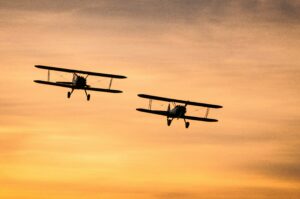Wings of Time: RC Planes Take History to New Heights


A Soaring Legacy
Humanity has been fascinated with flight for centuries. From Icarus’s mythical wings to the Wright brothers’ daring experiments, our desire to conquer the skies has endured. That ambition has transformed drastically since 1903, when Orville and Wilbur Wright first took flight over the dunes of Kitty Hawk. But while commercial and military aviation have progressed into high-tech realms, a subculture continues to preserve and evolve the spirit of early aviation in an exhilarating, hands-on format: radio-controlled (RC) airplanes.
RC flying isn’t just a hobby; it’s a living homage to the evolution of aviation, reimagined for the modern age. These aircraft aren’t bound by commercial objectives or military utility. They’re personal creations—part historical replica, part technical innovation—that allow pilots and builders to blend engineering with artistry. At its heart, RC aviation is where nostalgia, creativity, and modern thrill-seeking converge remarkably.
From Balsa to Brushless Motors
RC planes had humble beginnings. In the 1930s and 40s, hobbyists crafted model planes from balsa wood and used rubber bands or gasoline-powered engines for propulsion. These early versions lacked accurate radio control, often relying on line-guided systems or free flight. The post-war era brought significant breakthroughs in remote control technology, allowing pilots to maneuver aircraft through handheld transmitters, marking the actual birth of RC flight as we know it.
Those once-imprecise controls have evolved into sophisticated 2.4 GHz radio systems in the modern era. Lithium-polymer batteries have replaced heavier, less reliable alternatives, and brushless motors now deliver power with near-silent efficiency. Today’s RC planes come in many designs: foam-bodied beginner kits, scale replicas of World War II fighters, electric-powered gliders, and acrobatic stunt planes that defy gravity in jaw-dropping mid-air performances.
Yet even amid this technological progress, many enthusiasts still cherish traditional construction techniques. Hand-carved balsa wings and fabric coverings, adorned with authentic insignias from vintage squadrons, are signs of deep respect for the aircraft that came before. For these builders, the process is not merely about function—it’s an act of historical preservation.
History in the Hands of Hobbyists
One of the most captivating aspects of RC aviation is its ability to revive aviation history. Clubs and solo flyers often recreate iconic aircraft with meticulous detail, from the nimble Supermarine Spitfire to the sleek P-51 Mustang. These models don’t just look the part; many fly with the same aerodynamic traits that defined their real-world counterparts.
These flying replicas are more than just toys—they’re experiential time machines. Watching a scale B-17 Flying Fortress take off from a grassy field, roaring with four synchronized electric motors, evokes more than awe; it’s an audible and visual tribute to the bravery and innovation of the 20th century. Even children watching for the first time can grasp the significance of these machines, transformed from museum relics into airborne storytellers.
Groups across the United States and beyond host RC airshows specifically for vintage models. These events are passionate gatherings where enthusiasts display craftsmanship, exchange design notes, and pay homage to aviation pioneers. The shared respect for history forms a powerful bond among participants that often spans generations of flyers.
Engineering for Adrenaline
Of course, modern RC flight is about more than preservation. The hobby’s technological edge has exploded in recent years, giving rise to performance-focused designs and daring aerobatics that push the boundaries of what’s possible on a small scale. High-speed jets with ducted fan propulsion systems can reach speeds over 150 mph. Meanwhile, FPV (first-person view) capabilities let pilots don VR goggles and fly from a cockpit perspective—virtually sitting in the plane they built.
Some thrill-seekers gravitate toward “3D flying,” a genre of aerobatics where planes perform torque rolls, flat spins, and hovering maneuvers with incredible precision. Others prefer the zen-like calm of soaring gliders, using only thermal currents and subtle controls to navigate silently across open skies. The spectrum of experience is vast, and every type of RC pilot finds a niche that reflects their personality.
What ties all of them together is freedom. Unlike piloting a drone for aerial photography or racing, RC planes carry no practical obligation. They exist purely for joy—joy in control, craftsmanship, nostalgia, and exploration.
The Future of RC Aviation
Looking ahead, the world of RC planes is poised to grow more inclusive and accessible. With affordable kits and intuitive simulators now available, newcomers can learn to fly without destroying their first model on takeoff. Apps and flight simulators replicate fundamental RC dynamics, allowing hobbyists to practice landings, loops, and crashes risk-free. Meanwhile, 3D printing is revolutionizing custom part manufacturing, making it easier for pilots to innovate with their designs or replicate rare aircraft components.
Environmental consciousness is also driving changes. As electric motors become more powerful and efficient, many flyers choose battery-powered planes over gas-powered models. This shift reduces noise and emissions and makes RC fields more accessible in urban areas where combustion engines are restricted.
In tandem, online communities—forums, YouTube channels, Discord groups—connect RC pilots across borders. Builders can trade ideas in real time, share crash footage, or organize virtual fly-ins with fellow enthusiasts halfway across the globe. This global network of creators ensures that RC aviation won’t just survive; it will flourish.
A Living Tribute to Flight
“Aerodynamic adventures” isn’t a buzz phrase—it captures the very essence of what RC planes offer: the thrill of flight, the elegance of engineering, and the reverence of history. As hobbyists launch their handcrafted legends into the sky, they’re not just flying models—they’re participating in a lineage of innovation, courage, and wonder. RC aviation may begin in backyards and airfields, but it takes the spirit of human flight to boundless new heights.
